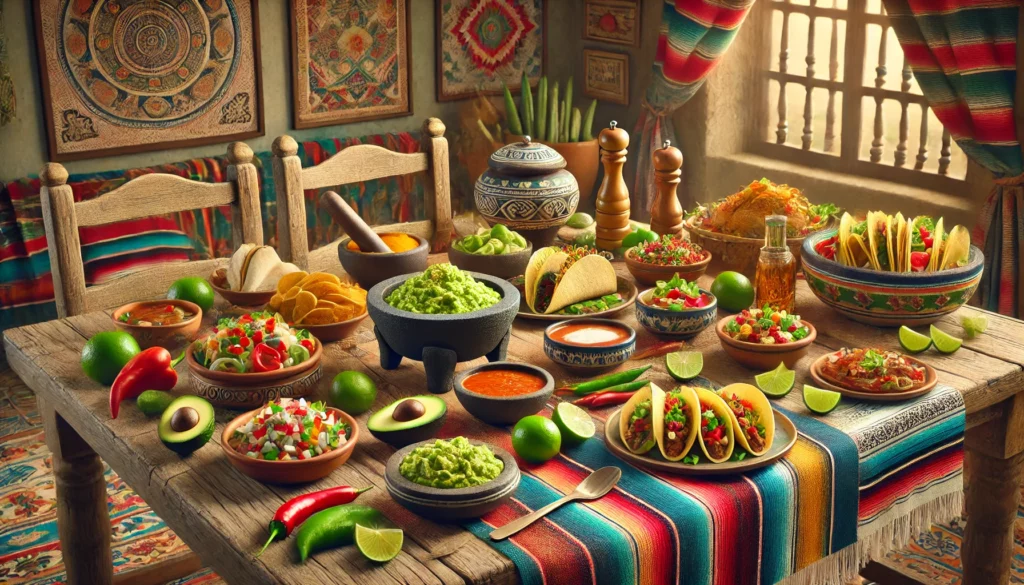Ads
When we think of Mexican cuisine, it's impossible not to recall the explosions of flavor, the distinctive aromas, and the rich cultural tradition that each dish carries with it.
But did you know how these delicacies came to be?
In this article, we'll explore the main Mexican cuisines, their origins, how they're prepared, and how they've evolved to conquer the palates of millions around the world.
The History of Mexican Cuisine
Mexican cuisine has its roots in ancient civilizations such as the Mayans and Aztecs, who used native ingredients like corn, beans, chili, and avocado in their recipes.
With the arrival of the Spanish in the 16th century, new elements such as pork, cheeses, and spices were incorporated, creating a rich and diverse culinary fusion.
Ads
Today, Mexican cuisine is recognized by UNESCO as an Intangible Cultural Heritage of Humanity, a reflection of its historical and cultural importance.
The Classics of Mexican Cuisine
Tacos: A Versatile Classic
Ah, tacos! Who hasn't tried this delicacy? Tacos are as varied as they are delicious.
Made with corn or wheat tortillas, they can be filled with meat, chicken, fish, or vegetarian options like mushrooms or squash.
The secret is in the accompaniments: guacamole, salsa, and lemon make all the difference.
If you visit Mexico, be sure to try tacos al pastor, filled with marinated pork and pineapple. A unique experience!
Guacamole: Simple and Sophisticated
Guacamole is a side dish that never disappoints.
Made with mashed avocado, onion, tomato, lemon, and cilantro, it's incredibly simple to prepare, but its flavor is unmistakable.
It is said that its origin dates back to the Aztecs, who already knew how to make the most of the avocado.
You can serve it with tortillas, nachos, or even as a sauce for grilled meats.
Chiles en Nogada: A Gastronomic Gem
This dish is an icon of Mexican sophistication.
Originally from the Puebla region, Chiles en Nogada are made from chiles stuffed with meat, fruit, and spices, covered with a walnut cream and decorated with pomegranate seeds.
In addition to being delicious, it's a dish that bears the colors of the Mexican flag: green, white, and red, making it special for national celebrations.
Ingredients that Make a Difference
Mexican cuisine is rich in authentic and flavorful ingredients.
Here are some of the most iconic ones:
- Corn: Base for tortillas, tamales and many other dishes.
- Chili: From the mild poblano pepper to the fiery habanero.
- Beans: An essential and versatile accompaniment.
- Avocado: Used in guacamole, salads and even desserts.
- Chocolate: Not only for sweets, but also in sauces like mole.
Variations and Sophistication
In recent years, Mexican cuisine has undergone a true revolution.
Renowned chefs around the world have reinterpreted traditional dishes, adding a touch of sophistication.
For example, gourmet tacos with ingredients like grilled shrimp and mango salsa are becoming increasingly popular.
Another trend is the use of chili peppers in desserts, such as chocolate brownies with a light touch of chipotle chili.
How to Prepare Mexican Dishes at Home
If you want to bring a little bit of Mexico into your kitchen, here are some tips:
- Start with the basics: Learn how to make homemade corn tortillas. They're easy and make all the difference.
- Experiment with different chilies: Each has a unique flavor that can transform a dish.
- Use fresh ingredients: Guacamole and salsas are much tastier with fresh tomatoes and avocados.
- Innovate: Don't be afraid to adapt recipes to include ingredients you love.

Curiosities about Mexican Cuisine
- The taco is so important in Mexico that there is even a “National Taco Day”!
- The word “chocolate” comes from Nahuatl, the language of the Aztecs.
- In Mexico, it's common to find street food vendors on almost every corner. Trying them is a culinary adventure in itself.
Conclusion
Mexican cuisine is much more than food; it's a cultural and sensorial experience.
Each dish tells a story, carrying traditions and celebrations that have spanned centuries.
How about exploring these delicacies at your next meal?
Whether at a Mexican restaurant, a food court, or in your own kitchen, immersing yourself in Mexican cuisine is always a good idea.
Share this article with friends and start your culinary journey through Mexico today.
FAQs
1. What makes Mexican cuisine unique?
Mexican cuisine is known for its rich combination of flavors, colors, and aromas, as well as its native ingredients such as corn, chili, avocado, and beans. The blend of indigenous and Spanish traditions makes it a unique and varied cuisine.
2. What are the most representative dishes of Mexican cuisine?
Some of the most iconic dishes include tacos, guacamole, chiles en nogada, enchiladas, mole poblano, and tamales. Each has its own history and flavor that reflects Mexico's culture and traditions.
3. What ingredients are essential in Mexican cuisine?
Corn is the basic ingredient, used for tortillas and tamales. Other essential ingredients are chili (in its many varieties), beans, avocado, tomato, and cacao, which is used in both desserts and savory sauces like mole.
4. What are chiles en nogada?
Chiles en nogada are a dish originating in Puebla consisting of poblano chiles stuffed with meat and fruit, covered with a walnut cream, and decorated with pomegranate seeds. It is considered a national symbol because of its colors, which represent the Mexican flag.
5. How can I prepare Mexican dishes at home?
To get started, you can learn how to make corn tortillas, guacamole, and fresh salsas. Experiment with different types of chili and use fresh ingredients for authentic flavors.
6. Is Mexican food spicy?
Not all Mexican dishes are spicy. Although chili is a common ingredient, there are many recipes with mild, balanced flavors that aren't spicy.
7. Why is Mexican cuisine a World Heritage Site?
UNESCO recognized it as an Intangible Cultural Heritage of Humanity for its rich history, diverse ingredients, and the important role it plays in Mexican cultural identity and traditions.